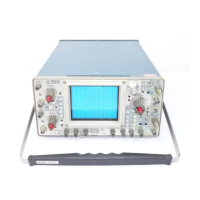Theory of
Operation—465B Service
CRT
Control Circuits
Focus of the crt display is controlled by FOCUS control
R4132. ASTIG adjustment R4178, which
is used
in con-
junction with the FOCUS control to provide
a
well-defined
display, varies the positive level on the astigmatism grid.
Geometry adjustment
R4069
varies the positive level on
the horizontal deflection plate shields
to
control
the
overall
geometry of
the display.
Two adjustments control the trace alignment by vary-
ing the magnetic
field
around the crt. Y-Axis adjustment
R4072 controls current through LI 41
65,
which affects the
crt
beam after vertical deflection but before horizontal
deflection. Therefore, it affects only the vertical (Y)
components of the
display.
TRACE ROTATION adjust-
ment R4179 controls the current through L14176 and
affects both vertical and horizontal rotation of the beam.
Z-Axis Amplifier
The Z-Axis Amplifier circuit controls the crt intensity
level from several inputs. The effect of these input signals
is to either increase
or
decrease the trace
intensity, or to
completely blank portions of the display. Input transistor
Q4223 is
a
current-driven, low
input impedance amplifier.
It provides termination for the input signals
as
well
as
isolation between the input signals and
the following
stages. Current signals
from the various control sources
are
connected
to the emitter of Q4223, and the algebraic
sum of these signals determines the collector conduction
level.
Transistors
Q4222,
Q4217, and Q4213are configured in
a feedback
amplifier arrangement with R4218 and R4221
as feedback elements and with
C4217
providing high-
frequency compensation. Emitter follower Q4222
provides the drive to complementary amplifier
Q4217-
Q4213. Diodes
CR4321, CR4218,
and
CR4115
provide
protection in the event of
high-voltage
arcing.
The Z-axis portion of the
Beam
Find circuit acts on the
input to the Z-Axis Amplifier. When the
BEAM FIND push
button is pressed, two events
occur:
First, +15 volts
is
applied to the anode
of
CR41 44 which lifts the emitter
of
Q4223
sufficiently positive
to ensure nonconduction of
the transistor. Second, R4321
becomes
connected to
—8
volts through R4314 to establish a fixed and predeter-
mined unblanking level at the output of the amplifier.
I hus, the INTENSITY control and all of theinput unblank-
ing signals have no control over the intensity level of the
crt
display whenever the BEAM FIND
push button is
pressed, and
a
bright trace will be displayed.
DC
Restorer
The DC Restorer
circuit provides crt control grid
bias
and couples both dc and lowfrequency
components of the
Z-Axis Amplifier
unblanklng signal to the crt control
grid.
This circuit allows
the Z-Axis Amplifier output
to control
the intensity
of
the crt display.
The potential difference
between
the Z-Axis Amplifier output and
the control grid
(about 2465 volts)
prevents direct signal coupling.
The
DC Restorer circuit's
ac
drive is taken from
the
center tap of
T4015.
Voltage
on the center tap is ap-
proximately 300 volts
p-p
at 50 kilohertz. A sample of this
sinusoidal voltage is fed through C4010 and R41
12
to the
junction of CR4111, CR4112, and R4111. The Crt Bias
Adjust (R4109)
sets the voltage level on the cathode
of
CR4111 to approximately +100 volts
dc.
When the
ac
sample
voltage rises to +100 volts, CR4111
becomes
forward
biased and
clamps the junction of CR4111
and
CR4112 to approximately +100
volts.
The Z-Axis Amplifier
output
voltage
level is
applied
via
R4113 to the anode
of
CR4112.
This voltage level varies
between +1 5 volts and +95 volts, dependi ng on t he setti ng
of the INTENSITY control. The sample voltage
will hold
CR4112 reverse biased until the voltage falls below
the Z-
Axis Amplifier output level. At that point CR41
12
becomes
forward biased and clamps
the
junction
of CR4111 and
CR4112 to the Z-Axis Amplifier output
level (see Figure
3-10).
Clamping the sample between +100 volts and the
positive voltage level set by the INTENSITY control
produces an approximate square-wave signal with
a
positive dc offset level.
The DC Restorer circuit is referenced to the
-2450
volts,
present on the crt cathode, through R4126 and
CR4123
to the
junction
of C4117 and
CR4122.
Initially,
C4117 will charge to
a
level determined
by the difference
between the Z-Axis Amplifier output level and
the
-2450
volt reference voltage. The charging path is from the
-2450
volt line, through R4126, CR4123,
C4117,
R4111,
CR41
12,
and R41
13
to the Z-Axis output.
Initially, C4118 will also be charged to
approximately
the same voltage as C4117 through R4126, CR4123,
and
CR4122 to the Z-Axis output.
When the sinusoidal sample voltage starts
its positive
transition from the lower clamped level
(+15
to
+95
volts)
toward the higher clamped level
(+100 volts), the charge
on C4117 increases due to the rising voltage at the anode
of CR4111. The additional
charge acquired by C4117 is
proportional to the amplitude
of
the positive
transition of
the clamped
sample voltage.
3-22

